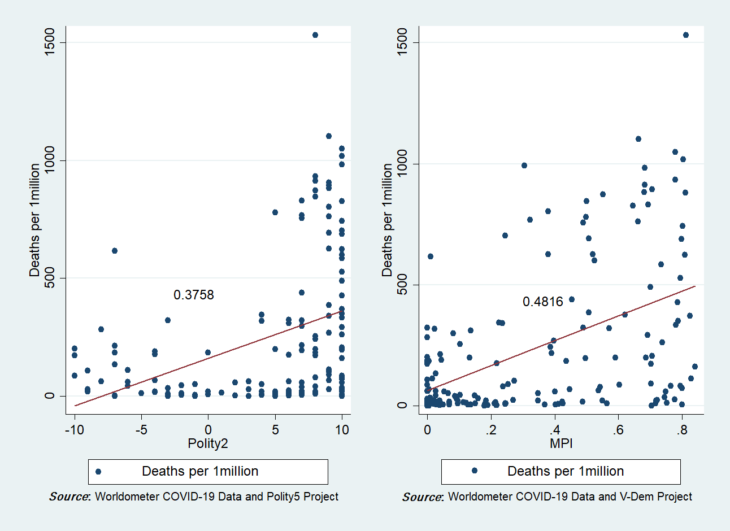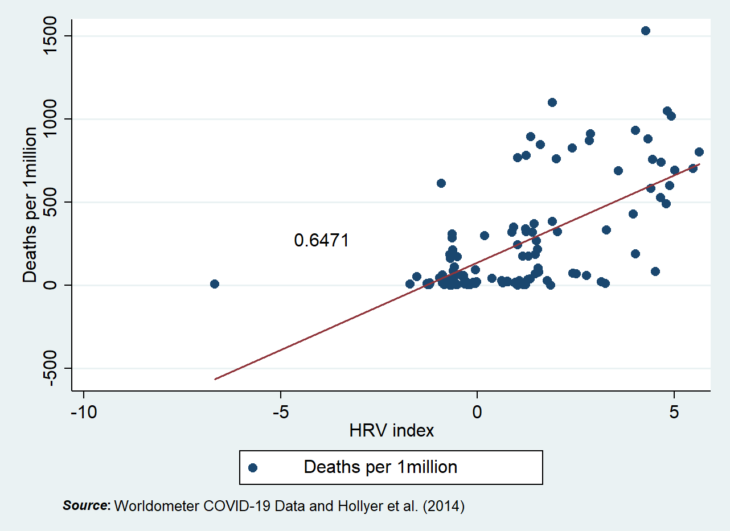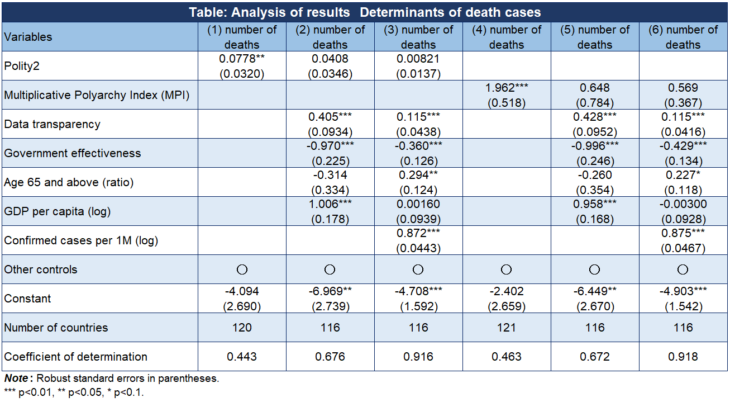An Empirical Analysis of Political Regimes in the COVID-19 Pandemic: Is democracy inferior to authoritarianism?
Annaka Susumu, Assistant Professor, Waseda Institute for Advanced Study, Waseda University

Dr. Annaka Susumu
COVID-19 is raging across the world. With the development and dissemination of vaccines, there are some signs that the spread of the virus is being contained in countries with advanced vaccination programs, but there is still no prospect of a complete exit.
In this unprecedented crisis, some are pessimistic that democracies are unable to respond to a large-scale pandemic in an active and functional way, and that a large number of deaths is inevitable. Indeed, a number of experts assert that authoritarian countries are better at dealing with COVID-19 than democratic countries because they can coercively restrict private rights swiftly. However, there remain deep-rooted doubts about the credibility of data on the number of positive cases and number of deaths published by governments of authoritarian countries. China in particular, believed to be the source of the novel coronavirus, has been lambasted by some who believe that the spread of the virus around the world is the result of China’s delay in acknowledging the spread of infection and in its initial response.
Can we really say definitively that the response of democratic countries to COVID-19 is inferior to that of authoritarian countries? If the analysis properly takes into account data reliability, it may not be possible to conclude that more deaths occur in democratic countries than in authoritarian countries. In this article, I would like to answer this question by presenting a systematic empirical analysis that accounts for not only the political regime, but also factors such as data transparency and government efficiency.
The relationship between political regime and number of deaths
Let me begin by providing simple graphs showing the relationship between the political regime and the number of deaths resulting from COVID-19. The two graphs shown in Figure 1 plot the degree of democracy for each country on the horizontal axis and the number of deaths per million population for each country on the vertical axis. The indices on the horizontal axis are both established indices employed by political scientists: the Polity2 score (ranging from -10 to +10, with +10 being the most democratic country) on the left hand side graph of Figure 1, and the Multiplicative Polyarchy Index (MPI) (ranging from 0 to 1, with 1 being the most democratic country) on the right hand side graph. The number of deaths on the vertical axis is cumulative until December 12, 2020, using data from the Worldometer. In order to avoid including in the data the effects of vaccination, which is being delivered around the world at different speeds for various reasons, the data employed is for 2020 rather than updated data from 2021.
Now, according to Figure 1, whichever scatterplot we look at, the numbers on the vertical axis tend to increase (number of deaths increases) as we move to the right on the horizontal axis (more democratic countries). The line that approximates the relationship between the two rises steadily from left to right, and the correlation coefficient is between 0.3 and 0.5, which shows a moderate positive correlation. The assertion at the beginning of this article that authoritarian countries are better at countering COVID-19 than democratic countries is based on these results.
However, Figure 1 can be interpreted in two entirely different ways. Here, the two interpretations are referred to as “efficient autocracy” and “biasing autocracy,” borrowing terms coined by economists Cassan and Steevoort (Cassan and Steevoort, 2021). Incidentally, while the term “autocracy” is no longer used by scholars specializing in politics as a standard political regime concept, here it can be considered to be synonymous with authoritarian regime.
Figure 1: Relationship between political regime index and COVID-19 death cases
“Efficient autocracy” is an interpretation based on the fact that democracy is a political regime that values individual freedom or rights and in which decision-making is slow. Conversely, it is argued that autocracy (= authoritarianism) is better and more efficient at curbing the number of deaths because it is easier for such a regime to enact policies that forcibly restrict the movement of people to prevent COVID-19 infection spread.
In contrast, “biasing autocracy” is the interpretation that the superiority of authoritarianism is only an apparent relationship. Researchers who support this interpretation assert that authoritarian countries are relatively more likely to manipulate COVID-19 data, and caution should be exercised in concluding that they have an advantage over democratic countries with respect to curbing the number of deaths. Further, they point out that when data is actually analyzed to identify any signs of fabrication of data in each country, a tendency to data manipulation has been observed in authoritarian countries in particular.
However, Cassan and Steevoort disagree with both these views, taking the eclectic position that while authoritarian countries do not necessarily engage in data manipulation to maintain their superiority, that does not mean they are actually superior. They argue that democratic countries and authoritarian countries differ in many respects, not only in their policy responses, and that these differences need to be accounted for. Below, I reanalyze the COVID-19 responses of various countries, emphasizing the importance of taking appropriate account of these factors.
Factors relating to political regime
One key concept in statistical inference is “control,” which states that in order to capture the effect of one variable (such as degree of democracy) on another variable, the effect of other variables must be removed. Conversely, unless the influence of other variables is removed, the relationship between the variable Y (number of deaths) to be explained and the explanatory variable X (such as degree of democracy) cannot be correctly inferred. In Figure 1 above, no account has been taken of the effects of these other variables.
Apart from the political regime, what factors should be considered as influencing the number of deaths resulting from COVID-19? Probably the first factor that comes to mind is the percentage of elderly people in the population. There is no doubt that one of the surest risk factors associated with severe illness from COVID-19 is old age. In general, democratic countries are known to have a higher rate of aging in the population as a whole than authoritarian countries. Therefore, in order to correctly ascertain the effect of the political regime, the analysis needs to remove (hold constant) the effect of aging. Other factors to consider include differences in the economic prosperity of each country: the more dynamic the economy, the greater the potential burden of restricting such activities. Since democratic countries are on average more affluent than authoritarian countries, the effect of economic prosperity also needs to be controlled.
In this study, I would like to focus on the transparency of data published by the governments of each country. For example, the data on COVID-19-related indicators published by countries that published more transparent economic data before COVID-19 is likely to be more reliable. On the other hand, the data published by countries that have not published highly transparent data in the past undoubtedly underestimates the true number of deaths from COVID-19 and number of positive cases. It is clear from the HRV Transparency Index created by Hollyer et al. (Hollyer et al., 2014) that such data transparency is closely related to differences across political regimes. That is, democratic countries are more likely to publish highly transparent data than authoritarian countries. Accordingly, data transparency is also an important consideration when it comes to control variables in this study.
Figure 2 shows the HRV Transparency Index (hereinafter referred to as data transparency). Its relationship with the data for the number of deaths is plotted on the horizontal axis (the further to the right, the higher the transparency). In the absence of recent data, data created in 2010 was employed. This should make no difference, however, since the results do not change significantly even if the analysis uses older data for multiple years. Furthermore, the number of countries plotted is somewhat limited due to the unavailability of data in some small countries, but even allowing for this, Figure 2 shows very clear results. Also, compared to the political regime index in Figure 1, the angle of the approximating line is steeper and the correlation coefficient has increased to about 0.65. In other words, rather than showing a relationship between the political regime and the number of deaths, here there is a strong tendency to report a higher number of deaths as transparency rises.
Figure 2: Relationship data transparency and COVID-19 death cases
Statistical analysis based on data transparency
In this section, I will systematically examine whether differences in political regime can be found to have an effect on COVID-19 death cases utilizing the Ordinary Least Squares (OLS) statistical method.
As well as the percentage of population over 65 years of age, GDP per capita, and data transparency, the estimation models also controlled for government effectiveness (efficient governments tend to be more common in democratic countries), population density, latitude/longitude, and the number of days since the first occurrence of positive cases. This is because, in addition to the impact of the above-mentioned factors, the effect of government responsiveness, ability to collect data, and geographically skewed COVID-19 death cases needed to be accounted for (these data were obtained from the World Bank and Johns Hopkins University). Except for variables such as political regime, data transparency, and the number of days since the occurrence of positive cases, logarithmically transformed data that accounts for skewed distribution is employed.[1]
The table shows the results of the analysis. Model 1 is a basic model only incorporating factors such as Polity2 score, and latitude and longitude. The two asterisks (**) next to the numbers reaffirm the statistically significant positive correlation as seen in Figure 1; that is, the more democratic the country, the higher the number of reported deaths (significance level, broadly speaking, is the level at which an event can be judged to be significant and unlikely to occur by chance. *** indicates a significance level of 1%, ** 5%, and * 10%, with a significance level of 1% being the most stringent, and anything above 10% usually not considered statistically significant).
However, model 2, which includes data transparency and factors that are believed to influence the analysis of the reported number of COVID-19 death cases, exhibits significantly different estimated results. Other variables, including data transparency and government effectiveness, are significant (data transparency is positive at a significance level of 1%, so the number of deaths increases as transparency rises. On the other hand, government effectiveness is negative, so the higher the effectiveness, the lower the number of deaths), but the statistical significance of Polity2 is lost by adding this control (* is lost).
In model 3, the number of positive cases is added for inclusion in the analysis, but like model 2, data transparency is positive and government effectiveness is negative with a significance level of 1%, indicating a consistent relationship. That is, countries that have disclosed highly transparent data in the past have more COVID-19 death cases, while conversely, countries with high government effectiveness have fewer deaths. When these factors are accounted for, a correlation between democracy or authoritarianism and the number of deaths can no longer be found.
In models 4 to 6, when the political regime index of Polity2 is changed to MPI, the results are almost the same as in models 1 to 3. Of these variables, data transparency alone shows a consistent positive correlation. An ability to publish highly transparent data may mean that a government’s administrative capability is high overall. However, even after controlling for government effectiveness, this shows that data transparency has a robust effect. Employing the coefficient of 0.405 indicated in model 2 and the range of variables called the interquartile range to calculate the effect size, an increase in data transparency alone would result in an approximately 1.7 times increase in the number of deaths reported.
Just to be certain, let us look at the other variables mentioned above. Models 2 and 5 suggest that high GDP per capita, in other words, prosperity, has the effect of increasing the number of deaths, while models 3 and 6 suggest that removing the number of positive cases has no effect. Further, models 2 and 5 show that the size of the population aged 65 years and above is unrelated to the number of deaths, but in models 3 and 6, when the effect of number of positive cases is accounted for, there is a statistically significant trend for the aging of the population to increase the number of deaths. The results suggest that, fundamentally, affluence is a problem prior to infection occurring, while old age is a problem after infection occurs.
The above analysis shows that there is only an apparent correlation between the political regime and the COVID-19 death cases, that is to say, authoritarian countries are not found to be superior when factors such as data transparency are accounted for in the analysis. These results are largely consistent with a recent study employing the excess mortality rate (Badman et al., 2021). For more than 200 years, the development of political democratization and liberalization that accompanied the new era of modernity have had a positive impact on human health (Annaka and Higashijima, 2021), with this global trend remaining steady in the COVID-19 pandemic. Considering that high data transparency is a kind of handicap, this suggests that it is premature to question the desirable effect of democracy.
Superiority of authoritarianism not observed
The COVID-19 pandemic has generated discourse that claims democratic countries may be vulnerable to large-scale pandemics. However, as stated above, when the impact of data transparency and other factors are accounted for, authoritarian countries are not found to be superior to democracies in terms of the response to COVID-19. Coupled with the recent turmoil faced by democratic governments worldwide, this raises questions about democratic values. In this article, I provide empirical evidence as a basis for a counterargument against such arguments.
Democracy and freedom are ideals established by human societies through long political struggles. As such, they must not be imprudently diminished. This article suggests that definitive judgments about the superiority or inferiority of a political regime cannot be made without properly controlling for various factors, not least of which is the effect of data transparency.
References
Annaka, S. (2021) Political Regime, Data Transparency, and COVID-19 Deaths Cases, SSM – Population Health, 15, 100832.
Annaka, S., and Higashijima, M. (2021) Political Liberalization and Human Development: Dynamic Effects of Political Regime Change on Infant Mortality across Three Centuries (1800-2015), World Development.
Cassan, G., Steenvoort, M.V. (2021) Political Regime and COVID 19 Death Rate: Efficient, Biasing or Simply Different Autocracies?, Available online: arXiv:2101.09960.
Hollyer, J. R., Rosendorff, B. P., and Vreeland, J. R. (2014) Measuring Transparency, Political Analysis, 22, 413-434.
Badman, R.P., Wu, Y., Inukai, K., Akaishi, R. (2021). Blessing or Curse of Democracy?: Current Evidence from the Covid-19 Pandemic, arXiv: 2105.10865.
Acknowledgments
I gratefully acknowledge the support of the Grant-in-Aid for Scientific Research (20K22079) from the Japan Society for the Promotion of Science (JSPS) as well as the advice of Endo Masahisa, Kita Munenori, Kohno Masaru, and Higashijima Masaaki. All errors are the responsibility of the author.
Translated from “Korona-ka ni okeru Seijitaisei no Jisshobunseki: Minshushugi wa Kenishugi ni otorunoka? (An Empirical Analysis of Political Regimes in the COVID-19 Pandemic: Is democracy inferior to authoritarianism?),” Chuokoron, September 2021, pp. 74-81 (Courtesy of Chuo Koron Shinsha) [October 2021]
[1] The results do not change significantly when the dependent variable is analyzed with the Poisson model and not logarithmically transformed. See Annaka (2021) for details.
Keywords
- Annaka Susumu
- Waseda Institute for Advanced Study
- Waseda University
- democracy
- authoritarianism
- degree of democracy
- COVID-19
- coronavirus
- political regime
- deaths
- efficient autocracy
- biasing autocracy
- data reliability
- data transparency
- population over 65
- GDP per capita
- government effectiveness





